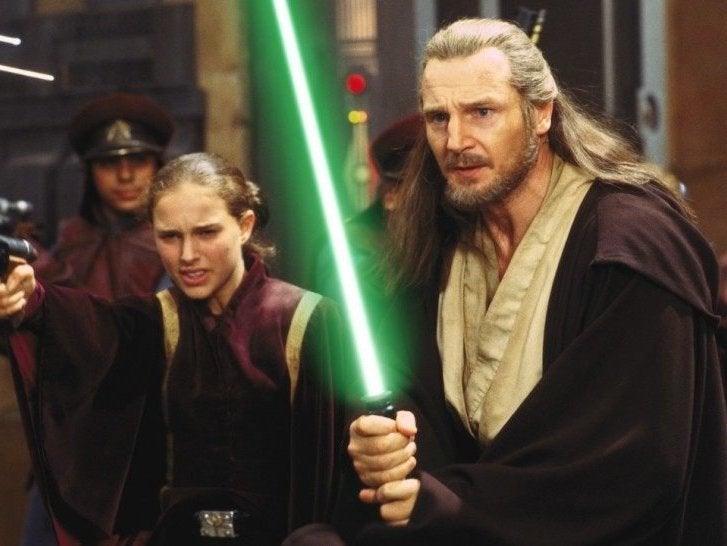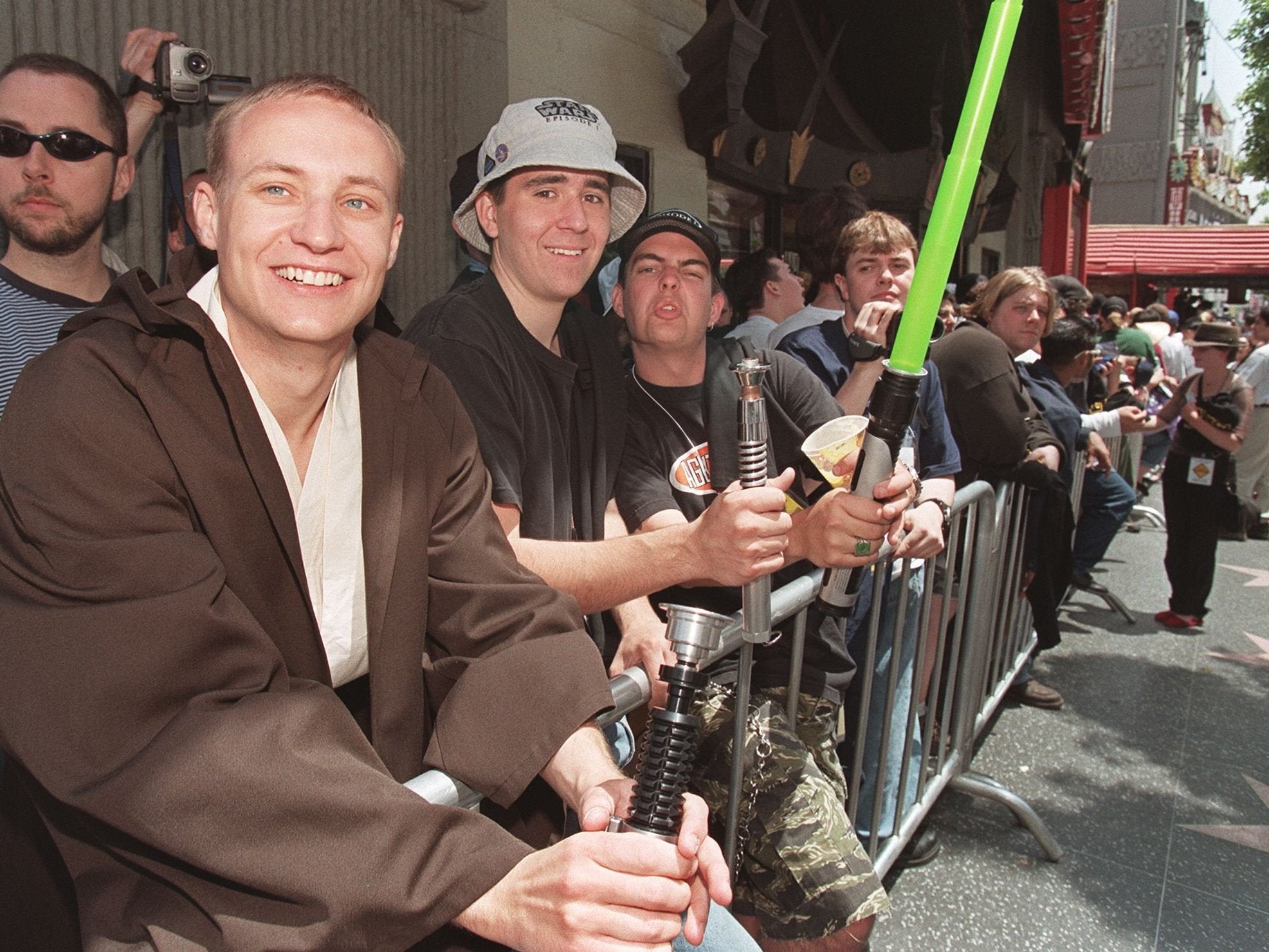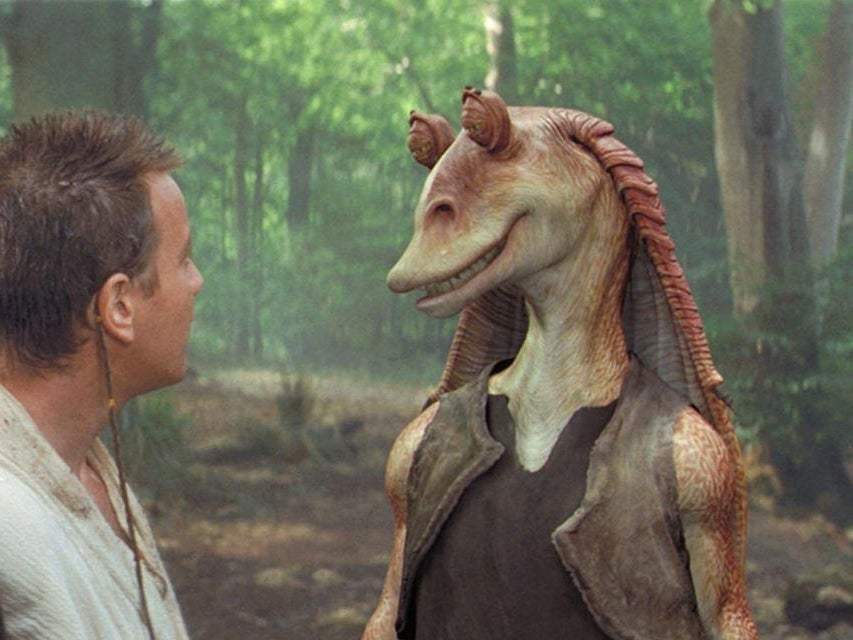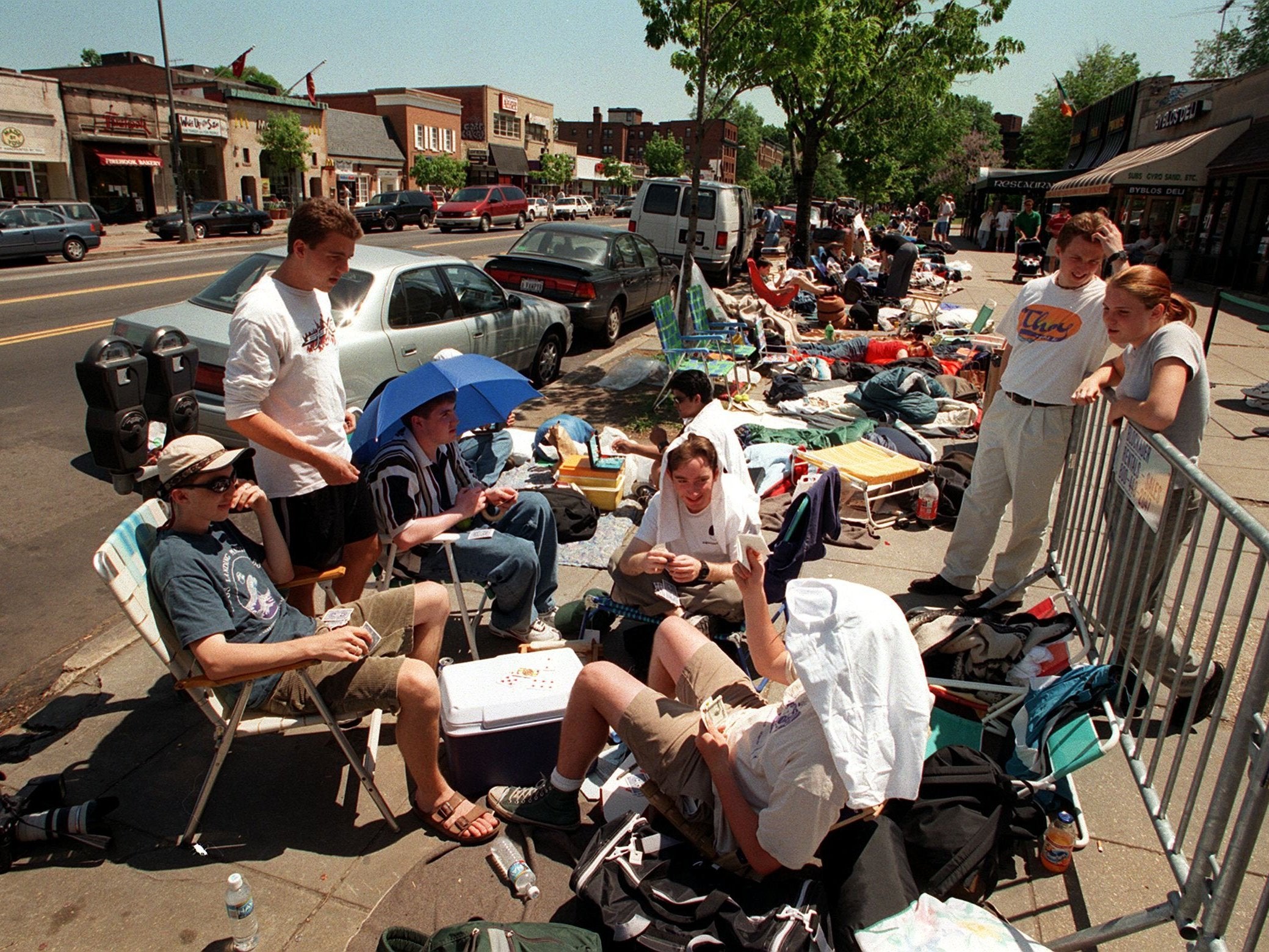The Phantom Menace at 20: Where did it all go wrong for George Lucas’s Star Wars prequel?
Fans camped out just to buy tickets for George Lucas’s fourth Star Wars venture, writes Al Horner, but the film left fans confused, disappointed and angry

Your support helps us to tell the story
From reproductive rights to climate change to Big Tech, The Independent is on the ground when the story is developing. Whether it's investigating the financials of Elon Musk's pro-Trump PAC or producing our latest documentary, 'The A Word', which shines a light on the American women fighting for reproductive rights, we know how important it is to parse out the facts from the messaging.
At such a critical moment in US history, we need reporters on the ground. Your donation allows us to keep sending journalists to speak to both sides of the story.
The Independent is trusted by Americans across the entire political spectrum. And unlike many other quality news outlets, we choose not to lock Americans out of our reporting and analysis with paywalls. We believe quality journalism should be available to everyone, paid for by those who can afford it.
Your support makes all the difference.In 2017, Peter Serafinowicz, the British comedian who voiced Darth Maul in the infamous Star Wars prequel Episode I: The Phantom Menace, sat down for a tell-all interview delving into the film’s creation. Naturally, everything he said was a lie. “It was meant to be a musical,” he said, deadpanning for 45 minutes about a Phantom Menace that never was. The script was originally packed with ghosts, he told the hosts of the Blank Check podcast, hence the movie’s title. To prepare for the role, Serafinowicz said, he moved to Tunisia and opened a shoe-repair shop, before coming to blows with director George Lucas on several occasions when filming began. The feud eventually boiled over into a violent medieval jousting match that culminated in the death of two elephants.
Serafinowicz’s account of Phantom Menace was outlandish, but honestly, not that much more so than the real Phantom Menace, which turns 20 today (19 May). This was, after all, a children’s film about taxes, trade disputes and a racist space frog almost played by Michael Jackson.
The year was 1999. Sixteen years after Return of the Jedi brought to a close the most influential and highest grossing film trilogy of all time, Lucas was reviving the Star Wars saga and all that went with it. Jedi knights! The Force! Lightsaber duels and dynasties torn between good and evil! The Phantom Menace had those things. But it also had lengthy sections set in science fiction’s answer to PMQs, scenes that exploded in seconds everything fans loved about the previous trilogy (midichlorians, anyone?) and characters who, even by 1999’s standards, were acknowledged as deeply problematic.
Where did it all go wrong? It’s a question fans and critics have been trying to unpack for 20 years now. The Phantom Menace was the biggest event in film history, the long-awaited continuation of a series that changed the face of cinema. The original Star Wars trilogy recalibrated almost every element of American movie-making. It ushered in new ages of special effects, marketing, merchandising and hero’s-journey storytelling. It was a phenomenon that amassed more than $1bn at the box office across three films, and billions more in toy sales and commercial deals. Following it up, every exec in Hollywood assumed, would be like shooting womp rats in a barrel.
Instead, The Phantom Menace confused audiences. Confusion led to disappointment, disappointment led to anger, anger led to hate and now, two decades later, The Phantom Menace remains ridiculed: a symbol of Hollywood hubris and the uneasy intersection between creativity and commerce (Lucas reportedly financed the film not through a Hollywood studio, but using a $100m cheque from toy company Hasbro, leading to suspicions that entire characters were devised because they’d make good action figures). How did the most anticipated movie of all time end up on the dark side of fans and critics? Was it really that bad? And how did its failure set up the success of Disney’s Marvel Cinematic Universe and the new series of Star Wars movies? The story doesn’t involve musical numbers, kung-fu fighting Beatles or dead elephants – but it’s every bit as bizarre.
The Phantom Menace was announced in 1993. In the years since Return of the Jedi, Star Wars fever had remained, thanks to a steady stream of toys, comics, expanded universe novels and so on. Lucas, who’d previously cancelled plans for further Star Wars sequels due to burnout, had found his urge to return to his galaxy far, far away reignited by advances in technology – namely CGI. He wrote outlines for three prequel films plotting the rise of Darth Vader, the Sith villain who’d terrorised A New Hope, The Empire Strikes Back, and Return of the Jedi. Steven Spielberg and Ron Howard were approached to direct, but both told Lucas this was his story to tell.
It didn’t take long for hysteria to take hold. The film’s impending release dominated every inch of the US media. “George Lucas’s [new] instalment of his deified space opera has so fully infiltrated every nook and cranny of the American experience, you’d think that Obi-Wan Kenobi is expected to blurt out a secret cure for cancer when the movie opens,” wrote CNN as fans camped outside cinemas for the movie’s teaser trailer – not even the actual film. Airlines reported a spike in flights to the US booked for the week of The Phantom Menace’s release by British fans who refused to wait for the film’s arrival in UK cinemas two months later (16 July). Cinema chains were forced to bring in measures to combat ticket touts buying up first-week tickets and selling them on for extortionate prices. As its 19 May release neared, fans began once again camping outside cinemas ensure their seats. “There’s no way this is going to be a disappointment!” one such fan assured a TV crew from behind a Darth Vader mask.

No one, in other words, had a bad feeling about this. But Lucas’s reported deal with Hasbro had put him in the strange position of having no studio to answer to; no one to interfere with his vision or reign in his ambitions. As a result, he was free to make a blockbuster that broke from Hollywood storytelling tradition, ripping up the rulebook on what usually makes movies tick. Who was the film’s protagonist? The Phantom Menace was not Anakin Skywalker’s (Jake Lloyd) story – he doesn’t enter till halfway through. Was it a tale about Jar Jar Binks (Ahmed Best) – a Forrest Gump-like story about an absurd, simple character who keeps accidentally finding himself in situations of grand importance? Lucas described it as the story of Queen Amidala (Natalie Portman) told through the lens of the Jedi helping her: Obi-Wan Kenobi (Ewan McGregor) and his patient tutor, Qui-Gon Jinn (Liam Neeson). But that didn’t check out either (protagonists usually have, you know, personalities).
The film’s lack of clear direction was also unconventional – a problem not lost on Lucas. “It’s bold in terms of jerking people around,” he admitted in the film’s making-of documentary. “I may have gone too far in a few places.” The plot unfolded at the pace of a Hutt on a hangover, crawling from planet to planet as the Jedi sought to resolve a trade dispute between a small planet, Naboo, and the evil Trade Federation – a mission that, across its 133 minute runtime, sees them encounter a young child slave with unprecedented force powers, and a clumsy amphibian who quickly became the most controversial character in Star Wars history.

Watch Apple TV+ free for 7 days
New subscribers only. £8.99/mo. after free trial. Plan auto-renews until cancelled

Watch Apple TV+ free for 7 days
New subscribers only. £8.99/mo. after free trial. Plan auto-renews until cancelled
“Jar Jar Binks makes the Ewoks look like f**king Shaft!” raged Simon Pegg’s character in the Noughties sitcom Spaced. Jar Jar wore flared bell-bottom trousers and spoke in heavy Caribbean patois (“Dissen gonna be bery messy! Me no watchin!”). He made Lucas look regrettably unaware of American entertainment’s dark tradition of “coon” caricatures, positioning black characters as dim-witted fools whose speech and idiocy are played for laughs. Lucas claimed the character was inspired by the Disney character Goofy and denied all accusations of racism, but many people were unconvinced. The Wall Street Journal called Jar Jar “a Rastafarian Stepin Fetchit”, a reference to the 1920s/30s actor synonymous with the term, having perpetuated negative black stereotypes across a number of roles throughout this period. “There was something about his demeanour that suggested blackness and that suggested, more specifically, stereotypical blackness,” Michael Dyson, professor of African-American studies at Columbia University complained to CNN after the film’s release.

The problem with The Phantom Menace’s approach to people of colour didn’t end with Jar Jar. Watto, a greedy, hook-nosed businessman whose love for cash not even the force could buckle (“your Jedi mind tricks don’t work on me, only money!”) was accused of pedalling antisemitism, while the cowardly Trade Federations bosses who wore mock oriental robes and spoke with exaggerated Asian accents also drew criticism.
Just as surprising was how the film misunderstood the magic of previous Star Wars films: their feel, their facade of a rough, ready lived-in universe. Replacing the grubby aesthetic of the original films, in which scuffs and scrapes covered every inch of the Death Star and rebel base, was a glossy green-screen sheen. Where A New Hope and co employed barrier-breaking practical effects, The Phantom Menace and its sequels were “computer generated”, Ewan McGregor later sighed. “It was a shame.” Similarly, the film threw out the original saga’s sense of a vast, unknowable universe full of exotic characters at every turn by revealing that half the key players had crossed paths before. C-3PO was built by Anakin Skywalker, it turned out. Jabba the Hutt was present at the pod race that won Anakin’s freedom. These connections gave a sense of Star Wars’ galaxy shrinking in on itself, like the inside of a trash compactor.
The frustrating thing was that The Phantom Menace also did a lot of things right. Composer John Williams’ dazzling Duel of the Fates; the film’s climactic three-person lightsaber showdown; Ray Park’s caged-tiger energy as the villain Darth Maul; and of course, the film’s pulse-quickening pod race sequence (if you ask me, this entire prequel trilogy should have been basically the Fast and Furious franchise set in Tatooine’s wretched pod racing underworld, full of gangsters, gamblers and nefarious speed junkies).

The movie also certainly did all it set out to achieve commercially. “The Phantom Menace seems designed more as a promotion for Lucasfilm’s billion-dollar merchandising concerns than a meaningful chapter in the Star Wars canon,” wrote The Hollywood Reporter at the time, correctly predicting a storming performance at the box office and beyond: the film grossed $1bn and millions more in toy sales and tie-in deals (if you’re wondering how low the film’s execs were willing to stoop, as part of one promotional deal with KFC, Colonel Sanders was written into Star Wars canon as having fought in the Battle of Naboo, dishing out “a bucket full of pain” to the dark side).
No amount of commercial success, though, could cover up the consensus that The Phantom Menace was a creative failure. The force was not with the film when it came to critics, who savaged Lucas’s creation with Maul-like malice. But 20 years later, in a time of factory-line Marvel movies that often – Infinity War and Endgame aside – repackage the same formula and sell it back to audiences time and time again, is there something to admire in its sheer strangeness? In its desire to do something different, twisting Star Wars into new shapes rather than regurgitating the originals? The optimism of the first trilogy was replaced in The Phantom Menace by a cynicism towards bureaucracy-suffocated political systems and the careerists that inhabit them, exploiting them for their own means. Its explanation of the mystic, ancient force as essentially a blood mutation called midichlorians might have had some fans in despair, but at least it attempted to push the series somewhere new, and expand its mythology.
Speaking of Marvel, The Phantom Menace might be to thank for the structure of modern franchises like the MCU. Today, hot Hollywood properties like Marvel (and indeed, Star Wars) are never entrusted to one auteur and their vision, but loaned out to custodians, one film at a time. Fifteen different directors, for instance, have manned the 22 MCU films so far. It could be argued that the unruliness of The Phantom Menace, on which Lucas had unmitigated free reign, helped lead to the current way big film franchises are handled, in which multiple directors are kept on short leashes, beholden to a wider, company-led vision for that film series, afraid of another Phantom Menace. Lucas had the freedom to remould Star Wars as his imagination, and his imagination alone, saw fit in 1999. In today’s more sanitised Hollywood, that would never be allowed again.
Last month at this year’s Star Wars Celebration event in Chicago, a Phantom Menace panel marked its 20th anniversary. Lucas, who sent in a message to fans, sounded still on the defensive regarding the much-maligned prequel. “[The Phantom Menace] is one of my favourite movies, and of course Jar Jar is my favourite character... It was very very hard.”
Its stars did indeed have a rough ride: Ahmed Best revealed last year that he considered suicide after the movie’s backlash, while Jake Lloyd has talked about how the film made his life “a living hell”. “Every saga has a beginning,” read the tagline for The Phantom Menace. It was almost Star Wars’ end: the film and its two equally flawed follow-ups (2002’s Attack of the Clones and 2005’s Revenge of the Sith) severely damaged the franchise’s reputation and cultural relevance, before Lucasfilm was sold to Disney in 2012.
Since then, though, the force has reawakened. Following a string of well-received Star Wars movies and spin-offs, director JJ Abrams will release the final instalment in the Skywalker saga, Episode IX: The Rise of Skywalker, this December. Little is known about the saga’s swansong but one thing’s for sure: it won’t be as bizarre as The Phantom Menace, the prequel that confounded a generation.
Join our commenting forum
Join thought-provoking conversations, follow other Independent readers and see their replies
Comments